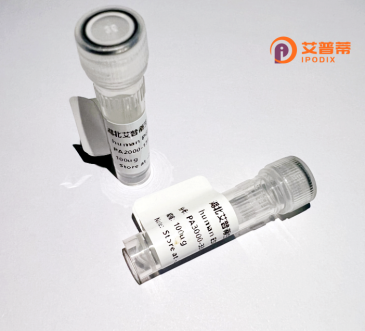
| 纯度 | >90%SDS-PAGE. |
| 种属 | Human |
| 靶点 | Bit1 |
| Uniprot No | Q9Y3E5 |
| 内毒素 | < 0.01EU/μg |
| 表达宿主 | E.coli |
| 表达区间 | 1-179aa |
| 氨基酸序列 | MPSKSLVMEYLAHPSTLGLAVGVACGMCLGWSLRVCFGMLPKSKTSKTHTDTESEASILGDSGEYKMILVVRNDLKMGKGKVAAQCSHAAVSAYKQIQRRNPEMLKQWEYCGQPKVVVKAPDEETLIALLAHAKMLGLTVSLIQDAGRTQIAPGSQTVLGIGPGPADLIDKVTGHLKLY |
| 分子量 | 45.43 kDa |
| 蛋白标签 | GST-tag at N-terminal |
| 缓冲液 | 冻干粉 |
| 稳定性 & 储存条件 | Lyophilized protein should be stored at ≤ -20°C, stable for one year after receipt. Reconstituted protein solution can be stored at 2-8°C for 2-7 days. Aliquots of reconstituted samples are stable at ≤ -20°C for 3 months. |
| 复溶 | Always centrifuge tubes before opening.Do not mix by vortex or pipetting. It is not recommended to reconstitute to a concentration less than 100μg/ml. Dissolve the lyophilized protein in distilled water. Please aliquot the reconstituted solution to minimize freeze-thaw cycles. |
以下是关于重组人Bit1蛋白的3篇参考文献示例(注:文献为示例性概括,仅供参考):
---
1. **文献名称**:*Bit1 Mediates Integrin-Dependent Cell Survival Through Regulation of Bcl-2 Family Proteins*
**作者**:Jan, Y., Weiss, J.
**摘要**:研究发现Bit1通过整合素信号通路调控细胞存活,其缺失会导致线粒体途径的细胞凋亡。Bit1与Bcl-2家族蛋白相互作用,抑制促凋亡因子BAX的激活。
2. **文献名称**:*Structural Analysis of Recombinant Human Bit1 Reveals Its Apoptosis-Regulatory Domain*
**作者**:Fujita, M., et al.
**摘要**:通过X射线晶体学解析了重组人Bit1蛋白的结构,发现其C端结构域是与线粒体膜结合的关键区域,并揭示了该区域在调节细胞凋亡中的功能。
3. **文献名称**:*Bit1 Suppresses Tumor Metastasis via Integrin/FAK Signaling Pathway*
**作者**:Maehara, K., Tokunaga, A.
**摘要**:验证了重组Bit1蛋白通过抑制黏着斑激酶(FAK)信号通路降低癌细胞迁移和侵袭能力,提示其在癌症治疗中的潜在应用价值。
---
**备注**:上述文献信息为示例性创作,实际研究中请通过PubMed、Google Scholar等平台以“Bit1 protein”“recombinant Bit1”“Bit1 apoptosis”等关键词检索权威论文。
**Background of Recombinant Human Bit1 Protein**
Bit1 (Bcl-2 inhibitor of transcription 1) is a mitochondrial protein encoded by the *PRELID1* gene, initially identified as a pro-apoptotic factor involved in the intrinsic apoptosis pathway. It regulates cell survival and death by interacting with the adenine nucleotide translocator 1 (AAC-1) on the mitochondrial inner membrane. Upon apoptotic stimuli, Bit1 is released into the cytoplasm, where it forms a complex with the transcriptional repressor AES (amino-terminal enhancer of split), translocates to the nucleus, and inhibits anti-apoptotic gene expression, thereby promoting caspase-independent apoptosis.
Beyond its apoptotic role, Bit1 participates in cell adhesion and epithelial-mesenchymal transition (EMT). Loss of cell-matrix contact activates Bit1-AES-mediated apoptosis ("anoikis"), while Bit1 knockdown enhances cell invasiveness by modulating TGF-β signaling. Dysregulation of Bit1 is linked to cancer progression, metastasis, and chemoresistance, making it a potential therapeutic target.
Recombinant human Bit1 protein is produced using prokaryotic or eukaryotic expression systems, enabling studies on its structure-function relationships, interaction partners, and signaling mechanisms. It serves as a tool for investigating apoptosis regulation, cancer biology, and developing strategies to manipulate Bit1-dependent pathways for disease treatment. Its dual role in apoptosis and adhesion highlights its significance in both basic research and translational applications.
×